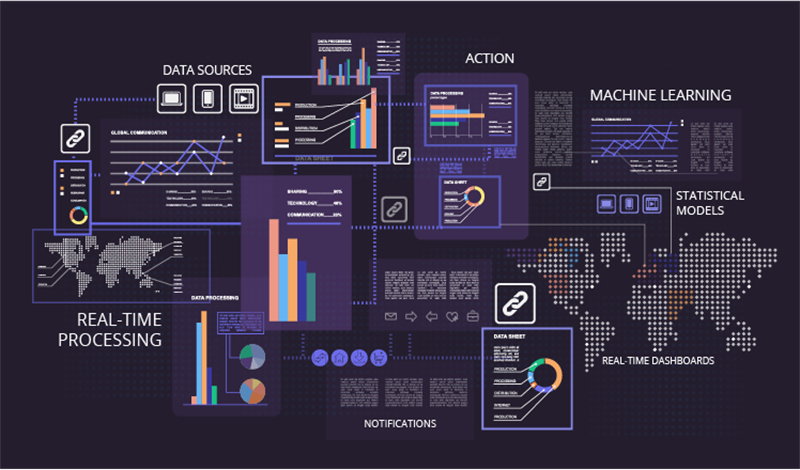To stay ahead of the competition, businesses need innovative solutions to manage and analyze vast amounts of data. Vector databases are a great tool for this purpose.
These databases leverage the power of manipulating vectors, elements that have size and direction. In the context of data, vectors can come in different types, including text, images, audio, and video. For instance, game developers working with the Unity engine need to handle a lot of 3D models.
These files can be represented in databases as vectors in the form of number sequences. The numbers correspond to attributes of the 3D asset, such as shape or color. This capability enables vector databases to store, process, and analyze complex data structures more effectively.
Here are 10 ways vector databases can improve business processes:
1. Scaling

Modern businesses generate and accumulate data at an unprecedented rate. Vector databases are designed to scale horizontally, allowing your business to seamlessly expand data storage and processing capabilities as your needs evolve.
Whether handling petabytes of data or accommodating a growing user base, these databases offer the scalability and flexibility required to support business growth without compromising performance.
2. Cost Management
Traditional relational databases are often tied to costly infrastructure investments and operational overhead. Vector databases offer a cost-effective alternative by delivering superior performance and scalability at a fraction of the cost.
By optimizing data storage, processing, and management workflows, these databases help businesses reduce total cost of ownership (TCO) and achieve greater ROI on their data infrastructure investments.
3. High-Speed Data Retrieval
Vector databases execute advanced indexing for high-speed data retrieval. By organizing data in a vectorized format, these databases can quickly locate and retrieve relevant information, reducing latency and improving overall system performance.
Pinecone founder and CEO Edo Liberty likens it to the human brain and how you can recall things like faces and art. This enhanced data retrieval capability is particularly valuable for businesses requiring real-time data processing, such as IoT solutions providers.
4. Optimized Data Resource
By applying vector processing techniques, vector databases can efficiently utilize CPU, memory, and storage resources to deliver optimal performance across diverse workloads. Whether it’s handling massive batch processing tasks or servicing thousands of concurrent user queries, these databases ensure efficient resource allocation to meet business demands.
This is especially vital to ventures that are purely digital by nature, such as a Bitcoin exchange website. Different transactions like trading and matching, wallet management, and user interface commands can all happen simultaneously. Vector databases can address such querying requests efficiently.
5. Efficient Similarity Search
Vector databases excel at performing similarity searches on large datasets. By representing data objects as vectors in a high-dimensional space, these databases can identify similar items based on their proximity in the vector space.
This feature is invaluable for businesses that use recommendation systems and content delivery networks (CDNs) where accurately matching similar items is essential for providing relevant results to customers.
6. Machine Learning Integration
Machine learning algorithms rely heavily on mathematical operations and vector representations of data. Vector databases can be set up to run with machine learning frameworks, allowing businesses to build and deploy sophisticated models for identifying patterns and building AI-driven applications.
MongoDB’s post on vector databases explains that they can be used for features like facial recognition and language processing. This is because vector databases can identify contextually similar data sets. By combining the power of vector databases with machine learning, businesses can unlock new opportunities for automation, optimization, and innovation across various domains.
7. Geospatial Analysis
Geospatial data is required in many industries, including logistics, construction, and environmental monitoring. Vector databases offer native support for geospatial data types and operations. Whether visualizing geographic patterns or optimizing delivery routes, these databases provide the tools necessary to extract valuable insights from spatial data.
8. Real-Time Analytics

Real-time analytics are essential for making data-driven decisions promptly. By processing complex analytical queries in real-time, vector databases can provide valuable insights into customer behavior, market trends, and operational performance.
9. Enhanced Data Security
Vector databases incorporate robust security features, including encryption, access controls, and auditing mechanisms, to safeguard sensitive information. Infoworld’s look at vector databases notes that they can even detect data anomalies through processing patterns, which help in mitigating security threats and fraudulent transactions.
By adhering to industry best practices and compliance standards, these databases help businesses avoid risks and maintain regulatory compliance.
10. Integration with Existing Infrastructure
Integrating new technologies into existing IT infrastructure can be daunting for businesses. Vector databases offer seamless integration with popular programming languages and data management tools, making it easy for businesses to incorporate them into their existing ecosystem. Regardless of on-premise or cloud deployments, these databases provide the flexibility and compatibility required to integrate seamlessly with existing workflows and applications.
From high-speed data retrieval and real-time analytics to seamless data platform integrations, vector databases provide a comprehensive solution for businesses seeking to drive innovation. They can help your business streamline operations, accelerate decision-making, and unlock new growth opportunities.
